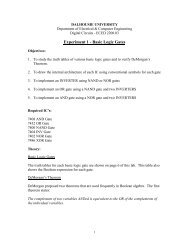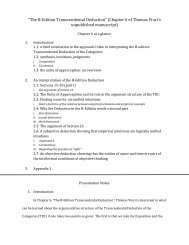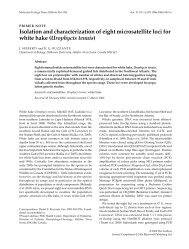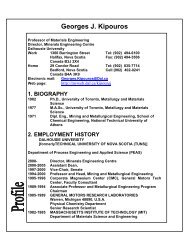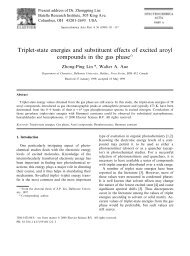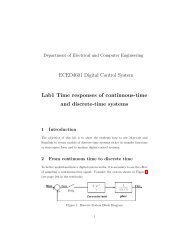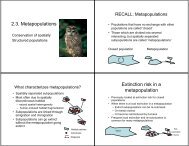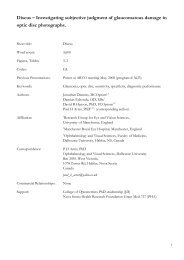Understanding and Modeling Organizational Systems - Myweb.dal.ca
Understanding and Modeling Organizational Systems - Myweb.dal.ca
Understanding and Modeling Organizational Systems - Myweb.dal.ca
You also want an ePaper? Increase the reach of your titles
YUMPU automatically turns print PDFs into web optimized ePapers that Google loves.
<strong>Underst<strong>and</strong>ing</strong> <strong>and</strong> <strong>Modeling</strong><br />
<strong>Organizational</strong> <strong>Systems</strong><br />
<strong>Systems</strong> Analysis <strong>and</strong> Design, 8e<br />
Ken<strong>dal</strong>l & Ken<strong>dal</strong>l
Learning Objectives<br />
• Underst<strong>and</strong> that organizations <strong>and</strong> their<br />
members are systems <strong>and</strong> that analysts need<br />
to take a systems perspective.<br />
• Depict systems graphi<strong>ca</strong>lly using context-level<br />
data flow diagrams, <strong>and</strong> entity-relationship<br />
models, use <strong>ca</strong>ses, <strong>and</strong> use <strong>ca</strong>se scenarios.<br />
• Recognize that different levels of<br />
management require different systems.<br />
• Comprehend that organizational culture<br />
impacts the design of information systems.<br />
Ken<strong>dal</strong>l & Ken<strong>dal</strong>l Copyright © 2011 Pearson Edu<strong>ca</strong>tion, Inc. Publishing as Prentice Hall 2-2
Three Main Forces Interacting to<br />
Shape Organizations<br />
• Levels of management<br />
• Design of organizations<br />
• <strong>Organizational</strong> cultures<br />
Ken<strong>dal</strong>l & Ken<strong>dal</strong>l Copyright © 2011 Pearson Edu<strong>ca</strong>tion, Inc. Publishing as Prentice Hall 2-3
Organizations Are Composed of<br />
Interrelated Subsystems<br />
• Influenced by levels of management<br />
decision makers that cut horizontally<br />
across the organizational system<br />
• Operations<br />
• Middle management<br />
• Strategic management<br />
• Influenced by organizational cultures<br />
<strong>and</strong> subcultures<br />
Ken<strong>dal</strong>l & Ken<strong>dal</strong>l Copyright © 2011 Pearson Edu<strong>ca</strong>tion, Inc. Publishing as Prentice Hall 2-4
Major Topics<br />
• Organizations as systems<br />
• Depicting systems graphi<strong>ca</strong>lly<br />
• Data flow diagram<br />
• Entity-relationship model<br />
• Use <strong>ca</strong>se modeling<br />
• Levels of management<br />
• <strong>Organizational</strong> culture<br />
Ken<strong>dal</strong>l & Ken<strong>dal</strong>l Copyright © 2011 Pearson Edu<strong>ca</strong>tion, Inc. Publishing as Prentice Hall 2-5
Organizations as <strong>Systems</strong><br />
• Conceptualized as systems designed to<br />
accomplish predetermined goals <strong>and</strong><br />
objectives<br />
• Composed of smaller, interrelated<br />
systems serving specialized functions<br />
• Specialized functions are reintegrated to<br />
form an effective organizational whole.<br />
Ken<strong>dal</strong>l & Ken<strong>dal</strong>l Copyright © 2011 Pearson Edu<strong>ca</strong>tion, Inc. Publishing as Prentice Hall 2-6
Interrelatedness <strong>and</strong><br />
Independence of <strong>Systems</strong><br />
• All systems <strong>and</strong> subsystems are interrelated<br />
<strong>and</strong> interdependent.<br />
• All systems process inputs from their<br />
environments.<br />
• All systems are contained by boundaries<br />
separating them from their environments.<br />
• System feedback for planning <strong>and</strong> control<br />
• An ideal system self-corrects or self-regulates<br />
itself.<br />
Ken<strong>dal</strong>l & Ken<strong>dal</strong>l Copyright © 2011 Pearson Edu<strong>ca</strong>tion, Inc. Publishing as Prentice Hall 2-7
System Outputs Serve as Feedback that<br />
Compares Performance with Goals (Figure 2.1)<br />
Ken<strong>dal</strong>l & Ken<strong>dal</strong>l Copyright © 2011 Pearson Edu<strong>ca</strong>tion, Inc. Publishing as Prentice Hall 2-8
<strong>Organizational</strong> Environments<br />
• Community<br />
• Physi<strong>ca</strong>l lo<strong>ca</strong>tion<br />
• Demographic profile (edu<strong>ca</strong>tion, income)<br />
• Economic<br />
• Market factors<br />
• Competition<br />
• Politi<strong>ca</strong>l<br />
• State <strong>and</strong> lo<strong>ca</strong>l government<br />
• Legal<br />
• Federal, state, regional, lo<strong>ca</strong>l laws, <strong>and</strong> guidelines<br />
Ken<strong>dal</strong>l & Ken<strong>dal</strong>l Copyright © 2011 Pearson Edu<strong>ca</strong>tion, Inc. Publishing as Prentice Hall 2-9
Openness <strong>and</strong> Closedness<br />
• Open<br />
• Free flow of information<br />
• Output from one system becomes input to<br />
another<br />
• Closed<br />
• Restricted access to information<br />
• Limited by numerous rules<br />
• Information only on a “need to know” basis<br />
Ken<strong>dal</strong>l & Ken<strong>dal</strong>l Copyright © 2011 Pearson Edu<strong>ca</strong>tion, Inc. Publishing as Prentice Hall 2-10
Virtual Organizations <strong>and</strong> Virtual<br />
Teams<br />
• A virtual organization has parts of the<br />
organization in different physi<strong>ca</strong>l<br />
lo<strong>ca</strong>tions.<br />
• Computer networks <strong>and</strong><br />
communi<strong>ca</strong>tions technology are used to<br />
bring virtual teams together to work on<br />
projects.<br />
Ken<strong>dal</strong>l & Ken<strong>dal</strong>l Copyright © 2011 Pearson Edu<strong>ca</strong>tion, Inc. Publishing as Prentice Hall 2-11
Benefits of Virtual Organizations<br />
<strong>and</strong> Teams<br />
• Possibility of reducing costs of physi<strong>ca</strong>l<br />
facilities<br />
• More rapid response to customer needs<br />
• Helping virtual employees to fulfill their<br />
familial obligations to children or aging<br />
parents<br />
Ken<strong>dal</strong>l & Ken<strong>dal</strong>l Copyright © 2011 Pearson Edu<strong>ca</strong>tion, Inc. Publishing as Prentice Hall 2-12
Taking a <strong>Systems</strong> Perspective<br />
• Allows system analyst to underst<strong>and</strong><br />
businesses before they begin their tasks<br />
• It is important that members of subsystems<br />
realize that they are interrelated with other<br />
subsystems.<br />
• Problems occur when each manager thinks<br />
that his/her department is the most<br />
important.<br />
• Bigger problems may occur when that<br />
manager rises through the ranks.<br />
Ken<strong>dal</strong>l & Ken<strong>dal</strong>l Copyright © 2011 Pearson Edu<strong>ca</strong>tion, Inc. Publishing as Prentice Hall 2-13
Taking a <strong>Systems</strong> Perspective<br />
(Figure 2.2)<br />
Outputs from one<br />
department serve as<br />
inputs for another such<br />
that subsystems are<br />
interrelated.<br />
Ken<strong>dal</strong>l & Ken<strong>dal</strong>l Copyright © 2011 Pearson Edu<strong>ca</strong>tion, Inc. Publishing as Prentice Hall 2-14
Perspective of Functional<br />
Managers (FIGURE 2.3)<br />
Ken<strong>dal</strong>l & Ken<strong>dal</strong>l Copyright © 2011 Pearson Edu<strong>ca</strong>tion, Inc. Publishing as Prentice Hall 2-15
Enterprise Resource Planning<br />
• Enterprise <strong>Systems</strong> or Enterprise<br />
Resource Planning (ERP) describes an<br />
integrated organizational information<br />
system.<br />
• Software that helps the flow of<br />
information between the functional<br />
areas within the organization<br />
Ken<strong>dal</strong>l & Ken<strong>dal</strong>l Copyright © 2011 Pearson Edu<strong>ca</strong>tion, Inc. Publishing as Prentice Hall 2-16
Depicting <strong>Systems</strong> Graphi<strong>ca</strong>lly<br />
• Context-level data flow diagrams<br />
• Entity-relationship model<br />
• Use <strong>ca</strong>se modeling<br />
Ken<strong>dal</strong>l & Ken<strong>dal</strong>l Copyright © 2011 Pearson Edu<strong>ca</strong>tion, Inc. Publishing as Prentice Hall 2-17
Context-Level Data Flow<br />
Diagrams<br />
• Focus is on the data flowing into <strong>and</strong><br />
out of the system <strong>and</strong> the processing of<br />
the data.<br />
• Shows the scope of the system:<br />
• What is to be included in the system.<br />
• The external entities are outside the scope<br />
of the system.<br />
Ken<strong>dal</strong>l & Ken<strong>dal</strong>l Copyright © 2011 Pearson Edu<strong>ca</strong>tion, Inc. Publishing as Prentice Hall 2-18
The Basic Symbols of a Data Flow<br />
Diagram (Figure 2.4)<br />
Ken<strong>dal</strong>l & Ken<strong>dal</strong>l Copyright © 2011 Pearson Edu<strong>ca</strong>tion, Inc. Publishing as Prentice Hall 2-19
Airline Reservation System<br />
(Figure 2.5)<br />
A context-level data<br />
flow diagram<br />
for an airline<br />
reservation system<br />
Ken<strong>dal</strong>l & Ken<strong>dal</strong>l Copyright © 2011 Pearson Edu<strong>ca</strong>tion, Inc. Publishing as Prentice Hall 2-20
Entity-Relationship Model<br />
• Focus is on the entities <strong>and</strong> their<br />
relationships within the organizational<br />
system<br />
• Another way to show the scope of a<br />
system<br />
Ken<strong>dal</strong>l & Ken<strong>dal</strong>l Copyright © 2011 Pearson Edu<strong>ca</strong>tion, Inc. Publishing as Prentice Hall 2-21
Relationships<br />
• Relationships show how the entities are<br />
connected.<br />
• Three types of relationships:<br />
• One-to-one<br />
• One-to-many<br />
• Many-to-many<br />
Ken<strong>dal</strong>l & Ken<strong>dal</strong>l Copyright © 2011 Pearson Edu<strong>ca</strong>tion, Inc. Publishing as Prentice Hall 2-22
Entity-Relationship Example<br />
(Figure 2.7)<br />
An entityrelationship<br />
diagram<br />
showing a<br />
many-to-one<br />
relationship<br />
Ken<strong>dal</strong>l & Ken<strong>dal</strong>l Copyright © 2011 Pearson Edu<strong>ca</strong>tion, Inc. Publishing as Prentice Hall 2-23
Examples of Different Types of<br />
Relationships in E-R Diagrams (Figure 2.8)<br />
Ken<strong>dal</strong>l & Ken<strong>dal</strong>l Copyright © 2011 Pearson Edu<strong>ca</strong>tion, Inc. Publishing as Prentice Hall 2-24
Entities<br />
• Fundamental entity<br />
• Associative entity<br />
• Attributive entity<br />
Ken<strong>dal</strong>l & Ken<strong>dal</strong>l Copyright © 2011 Pearson Edu<strong>ca</strong>tion, Inc. Publishing as Prentice Hall 2-25
Three Different Types of Entities<br />
Used in E-R Diagrams (Figure 2.9)<br />
Ken<strong>dal</strong>l & Ken<strong>dal</strong>l Copyright © 2011 Pearson Edu<strong>ca</strong>tion, Inc. Publishing as Prentice Hall 2-26
Attributes<br />
• Data attributes may be added to the<br />
diagram.<br />
Patron<br />
Patron Name<br />
Patron address<br />
Patron phone<br />
Patron credit <strong>ca</strong>rd<br />
Ken<strong>dal</strong>l & Ken<strong>dal</strong>l Copyright © 2011 Pearson Edu<strong>ca</strong>tion, Inc. Publishing as Prentice Hall 2-27
Creating Entity-Relationship<br />
Diagrams<br />
• List the entities in the organization.<br />
• Choose key entities to narrow the scope<br />
of the problem.<br />
• Identify what the primary entity should<br />
be.<br />
• Confirm the results of the above<br />
through data gathering.<br />
Ken<strong>dal</strong>l & Ken<strong>dal</strong>l Copyright © 2011 Pearson Edu<strong>ca</strong>tion, Inc. Publishing as Prentice Hall 2-28
A More Complete E-R Diagram Showing Data<br />
Attributes of the Entities (Figure 2-12 )<br />
Ken<strong>dal</strong>l & Ken<strong>dal</strong>l Copyright © 2011 Pearson Edu<strong>ca</strong>tion, Inc. Publishing as Prentice Hall 2-29
Use Case <strong>Modeling</strong><br />
• Describes what a system does without<br />
describing how the system does<br />
• A logi<strong>ca</strong>l model of the system<br />
• Use <strong>ca</strong>se is a view of the system<br />
requirements<br />
• Analyst works with business experts to<br />
develop requirements<br />
Ken<strong>dal</strong>l & Ken<strong>dal</strong>l Copyright © 2011 Pearson Edu<strong>ca</strong>tion, Inc. Publishing as Prentice Hall 2-30
Use Case Diagram<br />
• Actor<br />
• Refers to a particular role of a user of the system<br />
• Similar to external entities; they exist outside of<br />
the system<br />
• Use <strong>ca</strong>se symbols<br />
• An oval indi<strong>ca</strong>ting the task of the use <strong>ca</strong>se<br />
• Connecting lines<br />
• Arrows <strong>and</strong> lines used to diagram behavioral<br />
relationships<br />
Ken<strong>dal</strong>l & Ken<strong>dal</strong>l Copyright © 2011 Pearson Edu<strong>ca</strong>tion, Inc. Publishing as Prentice Hall 2-31
Actor<br />
• Divided into two groups<br />
• Primary actors:<br />
• Supply data or receive information from the<br />
system.<br />
• Provide details on what the use <strong>ca</strong>se should do.<br />
• Supporting actors:<br />
• Help to keep the system running or provide<br />
help.<br />
• The people who run the help desk, the<br />
analysts, programmers, <strong>and</strong> so on.<br />
Ken<strong>dal</strong>l & Ken<strong>dal</strong>l Copyright © 2011 Pearson Edu<strong>ca</strong>tion, Inc. Publishing as Prentice Hall 2-32
A Use Case Always Provides<br />
Three Things<br />
• An actor that initiates an event<br />
• The event that triggers a use <strong>ca</strong>se<br />
• The use <strong>ca</strong>se that performs the actions<br />
triggered by the event<br />
Ken<strong>dal</strong>l & Ken<strong>dal</strong>l Copyright © 2011 Pearson Edu<strong>ca</strong>tion, Inc. Publishing as Prentice Hall 2-33
Use Case Relations<br />
• Behavioral relationships<br />
• Communi<strong>ca</strong>tes<br />
• Used to connect an actor to a use <strong>ca</strong>se<br />
• Includes<br />
• Describes the situation in which a use<br />
<strong>ca</strong>se contains behavior that is common<br />
to more than one use <strong>ca</strong>se<br />
Ken<strong>dal</strong>l & Ken<strong>dal</strong>l Copyright © 2011 Pearson Edu<strong>ca</strong>tion, Inc. Publishing as Prentice Hall 2-34
Use Case Relations<br />
• Behavioral relationships (continued)<br />
• Extends<br />
• Describes the situation in which one use<br />
<strong>ca</strong>se possesses the behavior that allows<br />
the new <strong>ca</strong>se to h<strong>and</strong>le a variation or<br />
exception from the basic use <strong>ca</strong>se<br />
• Generalizes<br />
• Implies that one thing is more typi<strong>ca</strong>l<br />
than the other thing<br />
Ken<strong>dal</strong>l & Ken<strong>dal</strong>l Copyright © 2011 Pearson Edu<strong>ca</strong>tion, Inc. Publishing as Prentice Hall 2-35
Some Components of Use Case Diagrams Showing<br />
Actors, Use Cases, <strong>and</strong> Relationships for a Student<br />
Enrollment Example (Figure 2.13)<br />
Ken<strong>dal</strong>l & Ken<strong>dal</strong>l Copyright © 2011 Pearson Edu<strong>ca</strong>tion, Inc. Publishing as Prentice Hall 2-36
Examples of Use Cases, Behavioral Relationships<br />
for Student Enrollment (Figure 2.14)<br />
Ken<strong>dal</strong>l & Ken<strong>dal</strong>l Copyright © 2011 Pearson Edu<strong>ca</strong>tion, Inc. Publishing as Prentice Hall 2-37
Scope<br />
• System scope defines its boundaries:<br />
• What is in or outside the system<br />
• Project has a budget that helps to define<br />
scope<br />
• Project has a start <strong>and</strong> an end time<br />
• Actors are always outside of scope<br />
• Communi<strong>ca</strong>tion lines are the boundaries<br />
<strong>and</strong> define the scope<br />
Ken<strong>dal</strong>l & Ken<strong>dal</strong>l Copyright © 2011 Pearson Edu<strong>ca</strong>tion, Inc. Publishing as Prentice Hall 2-38
Developing Use Case Diagrams<br />
• Review the business specifi<strong>ca</strong>tions <strong>and</strong> identify the<br />
actors involved.<br />
• May use agile stories.<br />
• Identify the high-level events <strong>and</strong> develop the<br />
primary use <strong>ca</strong>ses that describe those events <strong>and</strong><br />
how the actors initiate them.<br />
• Review each primary use <strong>ca</strong>se to determine the<br />
possible variations of flow through the use <strong>ca</strong>se.<br />
• The context-level data flow diagram could act as a<br />
starting point for creating a use <strong>ca</strong>se.<br />
Ken<strong>dal</strong>l & Ken<strong>dal</strong>l Copyright © 2011 Pearson Edu<strong>ca</strong>tion, Inc. Publishing as Prentice Hall 2-39
A Use Case Diagram Representing a System<br />
Used to Plan a Conference (Figure 2.15 )<br />
Ken<strong>dal</strong>l & Ken<strong>dal</strong>l Copyright © 2011 Pearson Edu<strong>ca</strong>tion, Inc. Publishing as Prentice Hall 2-40
Developing the Use Case<br />
Scenarios<br />
• The description of the use <strong>ca</strong>se<br />
• Three main areas:<br />
• Use <strong>ca</strong>se identifiers <strong>and</strong> initiators<br />
• Steps performed<br />
• Conditions, assumptions, <strong>and</strong> questions<br />
Ken<strong>dal</strong>l & Ken<strong>dal</strong>l Copyright © 2011 Pearson Edu<strong>ca</strong>tion, Inc. Publishing as Prentice Hall 2-41
A Use Case Scenario Is Divided into Three Sections (Figure 2.16)<br />
Use <strong>ca</strong>se name: Register for Conference UniqueID: Conf RG 003<br />
Area: Conference Planning<br />
Actor(s): Participant<br />
Stakeholder Conference Sponsor, Conference Speakers<br />
Level Blue<br />
Description: Allow conference participant to register online for the conference using a secure Web site.<br />
Triggering Event: Participant uses Conference Registration Web site, enters userID <strong>and</strong> password, <strong>and</strong> clicks the logon button.<br />
Trigger type: External Temporal<br />
Steps Performed (Main Path) Information for Steps<br />
1. Participant logs in using the secure Web server userID, Password<br />
More steps included here…<br />
12. Successful Registration Confirmation Web page is sent to the participant Registration Record Confirmation Number<br />
Preconditions: Participant has already registered <strong>and</strong> has created a user account.<br />
Postconditions: Participant has successfully registered for the conference.<br />
Assumptions: Participant has a browser <strong>and</strong> a valid userID <strong>and</strong> password.<br />
Success Guarantee: Participant has registered for the conference <strong>and</strong> is enrolled in all selected sessions.<br />
Minimum Guarantee: Participant was able to logon.<br />
Requirements Met: Allow conference participants to be able to register for the conference using a secure Web site.<br />
Outst<strong>and</strong>ing Issues: How should a rejected credit <strong>ca</strong>rd be h<strong>and</strong>led?<br />
Priority: High<br />
Risk: Medium<br />
Ken<strong>dal</strong>l & Ken<strong>dal</strong>l Copyright © 2011 Pearson Edu<strong>ca</strong>tion, Inc. Publishing as Prentice Hall 2-42
Use Case Header Area<br />
• Has a name <strong>and</strong> a unique ID.<br />
• Include appli<strong>ca</strong>tion area.<br />
• List actors.<br />
• Include stakeholders.<br />
• Include the level.<br />
• Has a brief description of the use <strong>ca</strong>se.<br />
Ken<strong>dal</strong>l & Ken<strong>dal</strong>l Copyright © 2011 Pearson Edu<strong>ca</strong>tion, Inc. Publishing as Prentice Hall 2-43
Use Case Levels<br />
• Use <strong>ca</strong>se levels describe how global or<br />
detailed the use <strong>ca</strong>se description is:<br />
• White (like clouds): enterprise level<br />
• Kite: business unit or department level<br />
• Blue (sea level): user goals<br />
• Indigo (or fish): functional or subfunctional<br />
• Black (or clam): most detailed<br />
Ken<strong>dal</strong>l & Ken<strong>dal</strong>l Copyright © 2011 Pearson Edu<strong>ca</strong>tion, Inc. Publishing as Prentice Hall 2-44
Alternative Scenarios<br />
• Extensions or exceptions to the main<br />
use <strong>ca</strong>se<br />
• Number with an integer, decimal point,<br />
integer<br />
• Steps that may or may not always be<br />
used<br />
Ken<strong>dal</strong>l & Ken<strong>dal</strong>l Copyright © 2011 Pearson Edu<strong>ca</strong>tion, Inc. Publishing as Prentice Hall 2-45
Use Case Footer Area<br />
• Preconditions—need to be met before use<br />
<strong>ca</strong>se <strong>ca</strong>n be performed<br />
• Postconditions or the state of the system<br />
after the use <strong>ca</strong>se has finished<br />
• Assumptions<br />
• Minimal guarantee<br />
• Success guarantee<br />
• Outst<strong>and</strong>ing issues<br />
• Optional priority <strong>and</strong> risk<br />
Ken<strong>dal</strong>l & Ken<strong>dal</strong>l Copyright © 2011 Pearson Edu<strong>ca</strong>tion, Inc. Publishing as Prentice Hall 2-46
Four Steps Used to Create Use<br />
Cases<br />
• Use agile stories, problem definition<br />
objectives, user requirements, or a<br />
features list.<br />
• Ask about the tasks that must be done.<br />
• Determine if there are any iterative or<br />
looping actions.<br />
• The use <strong>ca</strong>se ends when the customer<br />
goal is complete.<br />
Ken<strong>dal</strong>l & Ken<strong>dal</strong>l Copyright © 2011 Pearson Edu<strong>ca</strong>tion, Inc. Publishing as Prentice Hall 2-47
Why Use Case Diagrams Are<br />
Helpful<br />
• Identify all the actors in the problem<br />
domain.<br />
• Actions that need to be completed are<br />
also clearly shown on the use <strong>ca</strong>se<br />
diagram.<br />
• The use <strong>ca</strong>se scenario is also<br />
worthwhile.<br />
• Simplicity <strong>and</strong> lack of techni<strong>ca</strong>l detail<br />
Ken<strong>dal</strong>l & Ken<strong>dal</strong>l Copyright © 2011 Pearson Edu<strong>ca</strong>tion, Inc. Publishing as Prentice Hall 2-48
The Main Reasons for Writing Use Cases Are<br />
Their Effectiveness in Communi<strong>ca</strong>ting with Users<br />
<strong>and</strong> Their Capturing of User Stories (Figure 2.18)<br />
Ken<strong>dal</strong>l & Ken<strong>dal</strong>l Copyright © 2011 Pearson Edu<strong>ca</strong>tion, Inc. Publishing as Prentice Hall 2-49
Management in Organizations Exists on Three Horizontal<br />
Levels: Operational Control, Managerial Planning <strong>and</strong><br />
Control, <strong>and</strong> Strategic Management (Figure 2.19)<br />
Ken<strong>dal</strong>l & Ken<strong>dal</strong>l Copyright © 2011 Pearson Edu<strong>ca</strong>tion, Inc. Publishing as Prentice Hall 2-50
Operations Control<br />
• Make decisions using predetermined<br />
rules that have predictable outcomes.<br />
• Oversee the operating details of the<br />
organization.<br />
Ken<strong>dal</strong>l & Ken<strong>dal</strong>l Copyright © 2011 Pearson Edu<strong>ca</strong>tion, Inc. Publishing as Prentice Hall 2-51
Managerial Planning <strong>and</strong><br />
Control<br />
• Make short-term planning <strong>and</strong> control<br />
decisions about resources <strong>and</strong><br />
organizational objectives.<br />
• Decisions may be partly operational <strong>and</strong><br />
partly strategic.<br />
Ken<strong>dal</strong>l & Ken<strong>dal</strong>l Copyright © 2011 Pearson Edu<strong>ca</strong>tion, Inc. Publishing as Prentice Hall 2-52
Strategic Management<br />
• Look outward from the organization to<br />
the future.<br />
• Make decisions that will guide middle<br />
<strong>and</strong> operations managers.<br />
• Work in highly uncertain decisionmaking<br />
environment.<br />
• Define the organization as a whole.<br />
Ken<strong>dal</strong>l & Ken<strong>dal</strong>l Copyright © 2011 Pearson Edu<strong>ca</strong>tion, Inc. Publishing as Prentice Hall 2-53
Managerial Levels<br />
• Different organization structure<br />
• Leadership style<br />
• Technologi<strong>ca</strong>l considerations<br />
• Organization culture<br />
• Human interaction<br />
• All <strong>ca</strong>rry impli<strong>ca</strong>tions for the analysis<br />
<strong>and</strong> design of information systems<br />
Ken<strong>dal</strong>l & Ken<strong>dal</strong>l Copyright © 2011 Pearson Edu<strong>ca</strong>tion, Inc. Publishing as Prentice Hall 2-54
<strong>Organizational</strong> Culture<br />
• Organizations have cultures <strong>and</strong><br />
subcultures.<br />
• Learn from verbal <strong>and</strong> nonverbal<br />
symbolism.<br />
Ken<strong>dal</strong>l & Ken<strong>dal</strong>l Copyright © 2011 Pearson Edu<strong>ca</strong>tion, Inc. Publishing as Prentice Hall 2-55
Verbal Symbolism<br />
• Myths<br />
• Metaphors<br />
• Visions<br />
• Humor<br />
Ken<strong>dal</strong>l & Ken<strong>dal</strong>l Copyright © 2011 Pearson Edu<strong>ca</strong>tion, Inc. Publishing as Prentice Hall 2-56
Nonverbal Symbolism<br />
• Shared artifacts<br />
• Trophies, etc.<br />
• Rites <strong>and</strong> rituals<br />
• Promotions<br />
• Birthdays, etc.<br />
• Clothing worn<br />
• Office placement <strong>and</strong> decorations<br />
Ken<strong>dal</strong>l & Ken<strong>dal</strong>l Copyright © 2011 Pearson Edu<strong>ca</strong>tion, Inc. Publishing as Prentice Hall 2-57
Summary<br />
• <strong>Organizational</strong> fundamentals<br />
• Organizations as systems<br />
• Levels of management<br />
• <strong>Organizational</strong> culture<br />
• Graphi<strong>ca</strong>l representation of systems<br />
• DFD<br />
• ERD<br />
• Use <strong>ca</strong>se diagrams <strong>and</strong> scenarios<br />
Ken<strong>dal</strong>l & Ken<strong>dal</strong>l Copyright © 2011 Pearson Edu<strong>ca</strong>tion, Inc. Publishing as Prentice Hall 2-58
Summary (Continued)<br />
• Levels of managerial control<br />
• Operational<br />
• Middle management<br />
• Strategic<br />
• <strong>Organizational</strong> culture<br />
Ken<strong>dal</strong>l & Ken<strong>dal</strong>l Copyright © 2011 Pearson Edu<strong>ca</strong>tion, Inc. Publishing as Prentice Hall 2-59



